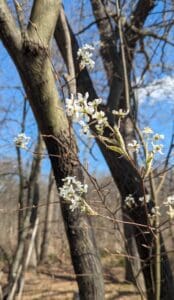
(Chelsea Update would like to thank Jennifer Fairfield, owner of The Garden Mill, for the information in this column. Part 1 ran on Saturday.)
Trees and Shrubs
The winter of 2013-2014 was very hard on a lot of trees and shrubs. If the weather didn’t do some of them in, the rabbits and deer did.
A number of trees were left in a weakened state after the weather we had, which left them vulnerable to other problems. I lost a plum tree to some sort of insect whose larvae bored trails through the wood over the summer – I haven’t determined what variety yet, but am still investigating. If you also lost trees or shrubs last year, now is also a good time to think about what you might want to do in their place.
Think about whether they were in the right place, and if you might need to try something else there, or if you liked the variety, look to see if you have a better spot in your yard for it. There is a saying amongst gardeners that goes “right plant in the right place.” That means taking into account the type of conditions a plant needs and the type of conditions you have in your yard before deciding that you just have to have a particular plant in a particular place. If you put something in a spot that isn’t right for it, it is likely that it will not do well.
Sometimes, it won’t do well even if it is in the right place, but if it’s in the wrong place, it is pretty much guaranteed. Again, planning is the key to success here, and now is a great time to do that planning.
There are a number of places to get information about plants, including the Missouri Botanical Garden’s Plant Finder. It is a great way to find out about plants for your specific conditions. Dave’s Garden is another really good resource that I use on a regular basis.
Indoor Plants
This month is a great time for taking care of your indoor plants, which may have been a bit neglected while you were busy outdoors. Make sure they are getting as much sun as possible now.
The winter in Michigan doesn’t provide a whole lot of sun, and even our sunny days aren’t as bright as they are in the summer, so moving your plants to a south-facing window or putting them closer to other windows will help them get as much sun as possible. Just don’t let them touch the glass, as it can be far too cold for most plants. Also, clean off any dust that has accumulated on leaves of your indoor plants so they can take better advantage of what sun they do get.
Give your indoor plants some humidity, too. Indoor air at this time of year is generally very dry, which is hard on plants. Provide them with a little extra humidity by putting a room humidifier near them or putting trays of water around them. Just be careful that the humidifier isn’t blowing right on them or creating a cold draft.
For most indoor plants, this should be a time when they don’t need fertilizer, or need less. There are some plants, such as African violets, that bloom all year round, so need regular fertilization all year. If you’re not sure what your plant needs, Houseplant411.com is a good website with lots of basic information, including fertilization needs, for a number of popular houseplants.
Being a book lover, my favorite resource for houseplant care is a book called “The Houseplant Expert” by Dr. D.G. Hessayon. It’s not a new book – mine goes back to 1991 – but the information in it is still relevant, and I rely on it all the time.
Birds
I never get tired of watching the birds in my yard. I try to keep the feeders full, but keeping up with them can be a challenge. It never fails that I fill up the peanut feeder, and by the next day, the Blue Jays have emptied it. They have other things they can eat until I fill it up again, but that is definitely their favorite.
Keeping your feeders filled in the winter provides the birds a reliable source of food, and you lots of entertainment.
Please consider providing the birds with a source of water during the winter. With temperatures going below freezing, water is hard to find when you live outdoors, but it’s no less important to birds than to us – but they can’t get it out of a faucet. Putting out a heated birdbath or putting a de-icer in your birdbath can be a literal lifesaver for birds during the winter.
Did you have a fresh cut Christmas tree this year? If so, when you are ready to take it down, consider putting it to use in your yard, rather than putting it out on the curb for trash pick-up. The National Wildlife Federation has some great ideas for ways to use your tree, including as shelter for your birds, or even a bird feeder.














